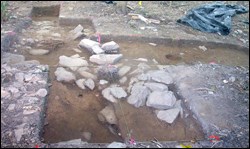|
Historical Research A colonial tavern and ferry, located on the Thomas Farm, are among the many fascinating cultural resources at Monocacy. The first known reference to the ferry appears in 1748, when Henry Ballenger was authorized by the Frederick County Court "to keep a ferry at the Middle Ford on Monocacy and to provide a boat or Scow and an able hand or hands to work it." It was further required that Ballenger not "demand or take more than four pence for carrying a Man and horse over and three shillings for Waggons." The first reference to a tavern near the ferry appears in 1754, when Daniel Kennedy was awarded a license "to keep a house of Entertainment in the County of Frederick in the late Dwelling House of Richard Richardson [near Middle Ford]." The presence of a tavern at the ferry was customary; most colonies required ferry operators to keep taverns at ferry crossings as colonial travel was often difficult, hazardous, and tiring. In 1755, during the French and Indian War, Daniel Kennedy ferried British General Edward Braddock's troops over the Monocacy River prior to their ill-fated march to Fort Duquesne. A member of Braddock's column recorded the event:
The licensing for the ferry and tavern changed hands several times over the years, but it appears to have been continuously occupied and operated. In 1805, the State of Maryland chartered the Georgetown Pike, and around 1828 a covered bridge was constructed to span the Monocacy River. These improvements necessitated a realignment of the road, bypassing the tavern and rendering the ferry obsolete. The tavern was abandoned by about 1830. To learn more about the early settlement of the Monocacy region, visitors can walk the Middle Ford Ferry Loop trail on the Thomas Farm, one of several walking trails at Monocacy National Battlefield. 
Between 2004 and 2008, NPS archeologists undertook several phases of excavation at the site of the Middle Ford Ferry Tavern. Oral traditions and historic research helped determine the tavern's general location, which was further refined using traditional archeological methods. Excavations at the Middle Ford Ferry Tavern site revealed the footprint of a small structure, including the remains of its cellar, hearth, and chimney. A wide variety of artifacts were also recovered: architectural materials such as brick, mortar, and hand-wrought nails; fragments of English and American pottery and glass; and personal effects such as buttons, shoe buckles, and tobacco pipes. Dateable artifacts recovered from the tavern site confirm that it was abandoned by about 1830. The Middle Ford Ferry Tavern is the park's earliest known historic site. Although the tavern and ferry were abandoned long before the Battle of Monocacy, they are illustrative of the vital trade and transportation routes that made Monocacy Junction so strategically important during the Civil War. Learn more about the Middle Ford Ferry Tavern archeological project. 
|
Last updated: March 28, 2024
